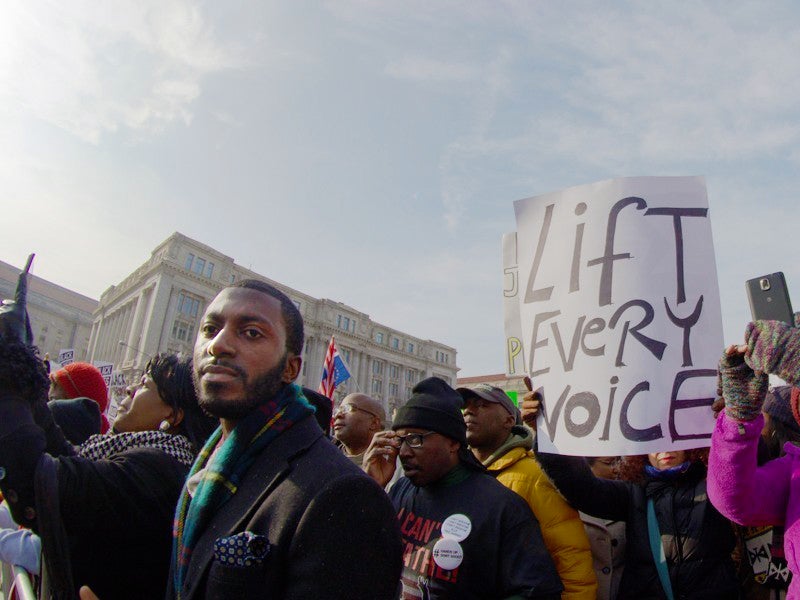Frontline Communities Seeking Solutions Unite for Peoples Climate March
Environmental justice groups will keep the needs of overburdened communities front-and-center during this week’s Peoples Climate March.

This page was published 8 years ago. Find the latest on Earthjustice’s work.
Environmental justice groups will descend on Washington, D.C., this weekend from around the country to ramp up their fight against climate change. They will come together on April 29th for the Peoples Climate March march, walking from the U.S. Capitol to the White House and finally to the Washington Monument.
The public is unified in its opposition to President Trump’s pro-polluter agenda, which involves gutting health and environmental protections and reversing course on efforts to slow or stop climate change. However, environmental justice groups’ messages on climate change are different from those typically sent by large, national environmental groups because the communities they live in and advocate for face greater than average environmental burdens.
“We’re having to say it over and over again: Frontline communities are the ones that are most impacted,” says Kim Noble, director of national partnerships at the Oakland-based organization Green for All. “This administration has made it clear that they’re not standing with our vulnerable communities in the fight against climate change and pollution. When we think about the solution, we can’t look to the federal government.”
“This administration has made it clear that they’re not standing with our vulnerable communities in the fight against climate change and pollution. When we think about the solution, we can’t look to the federal government.”
Noble says the differences between former President Obama’s approach to environmental protection and Trump’s are vast.
“The previous administration continued to strengthen protections to guard our air and provide clean and safe drinking water. This administration is doing the opposite in rolling back those protections,” she says. “We’re going to have to look to the states to step up and go bold in advancing climate change policies that protect frontline families.”
Green for All works to build an inclusive green economy and ensure that people of color have a voice in the national and international climate movement.
Communities of color and low-income communities tend to be situated closer to major sources of pollution, such as congested highways, polluting power plants and toxic oil refineries. They tend to breathe worse air, and consequently have higher rates of asthma. People of color also face greater exposure to toxins that can cause cognitive problems in children, including lead.
Communities of color and low-income communities tend to be situated closer to major sources of pollution, such as congested highways, polluting power plants and toxic oil refineries.
For these groups, climate change does not seem like a far-off, global phenomenon. The pollution that causes climate change is harming lives on the ground where they live, work and play right now in very harmful, very tangible ways. This pollution leads to missed days of work and school from illness and, at its worst, means an early death. Addressing the problem is not optional—it’s essential.
“Even with all the rollbacks, we’re still here and we’re still fighting,” says Adrienne Hollis, director of federal policy for the Harlem, New York-based We Act for Environmental Justice. Her group and others are working to not only highlight the magnitude of the problem in their communities, but also to find innovative ways to fix it.
Environmental justice groups say that because the impacts of climate changing pollution are greatest in their neighborhoods, they must be included in the search for solutions, including plans to reduce carbon emissions and switch to renewable energy sources like wind and solar. They don’t want to be ignored or to see their communities become sacrifice zones that don’t experience the benefits of pollution controls to prevent climate change.
“We’re still here and we’re still fighting.”
We Act was founded in 1988 when community leaders in the West Harlem neighborhood found that environmental discrimination—the disproportionate exposure of communities of color to polluted air, water and soil—was a major problem that had to be tackled through political change.
The organization works to build healthier communities by ensuring that people of color and low-income families can participate in building sensible and fair environmental policies. We Act was recently successful in pushing the New York City Council to establish an environmental justice advisory board that will focus on addressing environmental justice issues in overburdened communities.
Hollis says We Act tries to convey its belief to people in the West Harlem community—and the world—that change is possible.
“People can make a difference,” Hollis says. “They should step up and take their rightful place at the table.” In fact, she says, “We should be leading the effort.”
Click here to learn more about the Peoples Climate March and find out how you can join the march in Washington, D.C., or a city near you. Download and print your own signs for the march here.
This blog was originally published as an op-ed for The Huffington Post.
Earthjustice’s Washington, D.C., office works at the federal level to prevent air and water pollution, combat climate change, and protect natural areas. We also work with communities in the Mid-Atlantic region and elsewhere to address severe local environmental health problems, including exposures to dangerous air contaminants in toxic hot spots, sewage backups and overflows, chemical disasters, and contamination of drinking water. The D.C. office has been in operation since 1978.